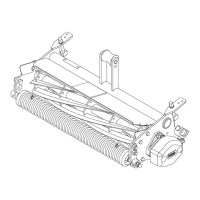Greensmaster 3250--D
Page 5 -- 6
Electrical System
Troubleshooting
CAUTION
Remove all jewelry, especially rings and
watches, before doing any electrical trouble-
shooting or testing. Disconnect the battery
cables unless the test requires battery voltage.
Foreffectivetroubleshooting andrepairs,theremustbe
agoodunderstandingoftheelectricalcircuitsandcom-
ponentsused onthismachine(seeelectricalschematic
and other electrical drawings in Chapter 9 -- Foldout
Drawings).
If the machine has any interlock switches by--passed,
they must be reconnected for proper troubleshooting
and safety.
Starting Problems
Problem Possible Causes
Starter solenoid clicks, but starter will
not crank
(if solenoid clicks, problem is not in
safety interlock system).
Battery is discharged.
Battery cables are loose or corroded.
Battery ground to frame is loose or corroded.
Wiring at starter is faulty.
Starter solenoid is faulty.
Starter mounting bolts are loose or not supplying a sufficient ground for
solenoid operation.
Starter is faulty and causing an incomplete circuit for the solenoid.
Nothing happens when start attempt is
made.
Functional control lever is not in the NEUTRAL position.
Battery is discharged or faulty.
Wiring to start circuit components is loose, corroded or damaged (see
Electrical Schematic in Chapter 9 -- Foldout Drawings).
Battery cables are loose or corroded.
Battery ground to frame is loose or corroded.
Fusible link harness at the engine starter motor has faulty link(s).
Fuse F3 (15 ampere) is faulty.
Start relay or circuit wiring is faulty.
Start interlock relay or circuit wiring is faulty.
Neutral sensor is out of adjustment or faulty.
The ignition switch or circuit wiring is faulty.
Starter solenoid or circuit wiring is faulty.
Starter motor is faulty.
High temperature relay, run relay and/or high temperature switch are
faulty.

